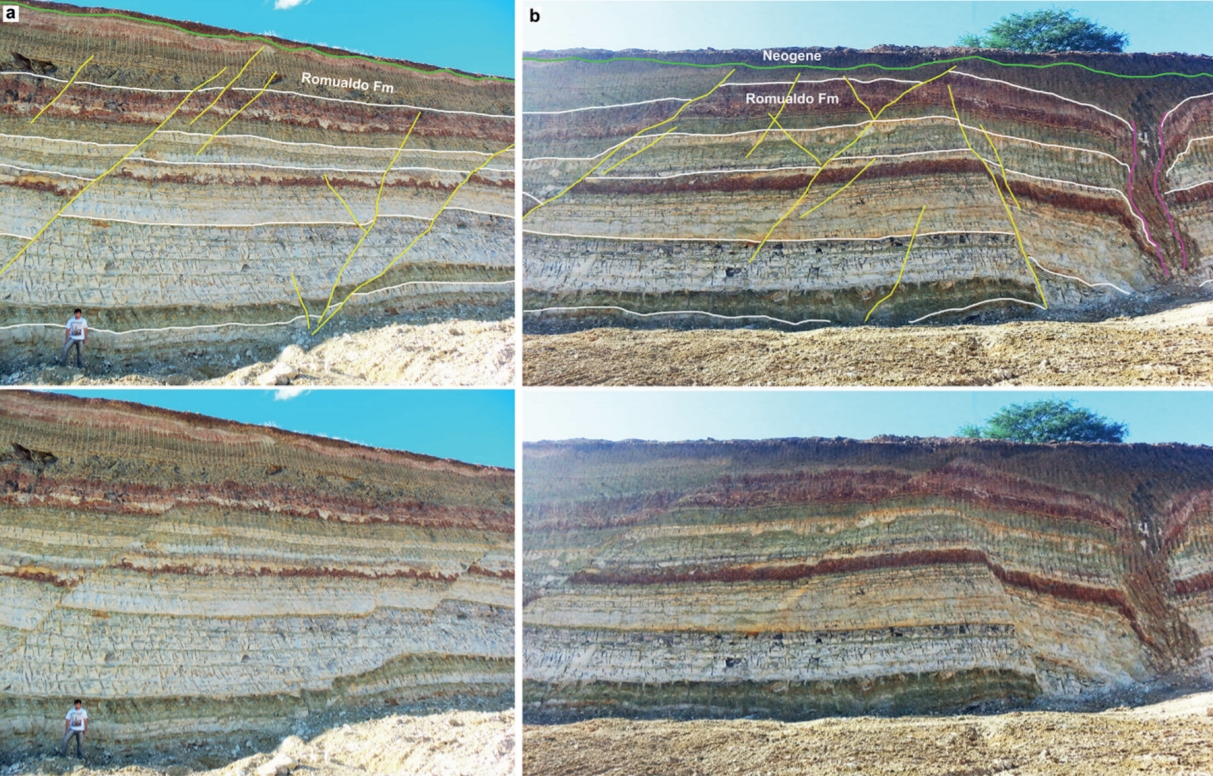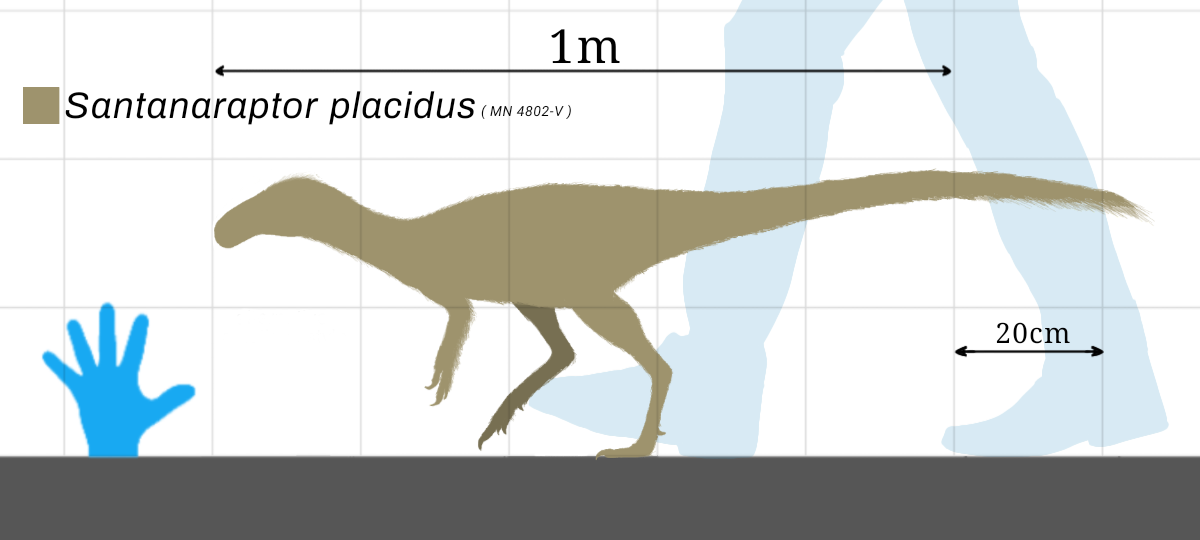|
Aratasaurus
''Aratasaurus'' (meaning "lizard born of fire") is a monotypic genus of basal coelurosaurian theropod which includes a single species, ''Aratasaurus museunacionali'', known from fossils found in deposits of the Romualdo Formation in Brazil. ''Aratasaurus'' lived during the Albian stage of the Early Cretaceous (111-108 Ma; possibly as early as 115 Ma). Discovery and naming The holotype, MPSC R 2089, was discovered in a plaster mine in 2008, and the holotype fossil was taken to the Plácido Cidade Nuvens Museum of Paleontology to be prepared and described. Between 2008 and 2016, microscopic analyses of the tissues of the holotype were made using small samples of the bones. Also in 2016, the holotype was taken to the National Museum of Brazil; on September 2, 2018, the museum was heavily damaged in a fire, but the area where the holotype was stored remained intact. In 2020, the holotype was described as the new genus ''Aratasaurus''. Only the right hind limb was collected, although ... [...More Info...] [...Related Items...] OR: [Wikipedia] [Google] [Baidu] |
Aratasaurus
''Aratasaurus'' (meaning "lizard born of fire") is a monotypic genus of basal coelurosaurian theropod which includes a single species, ''Aratasaurus museunacionali'', known from fossils found in deposits of the Romualdo Formation in Brazil. ''Aratasaurus'' lived during the Albian stage of the Early Cretaceous (111-108 Ma; possibly as early as 115 Ma). Discovery and naming The holotype, MPSC R 2089, was discovered in a plaster mine in 2008, and the holotype fossil was taken to the Plácido Cidade Nuvens Museum of Paleontology to be prepared and described. Between 2008 and 2016, microscopic analyses of the tissues of the holotype were made using small samples of the bones. Also in 2016, the holotype was taken to the National Museum of Brazil; on September 2, 2018, the museum was heavily damaged in a fire, but the area where the holotype was stored remained intact. In 2020, the holotype was described as the new genus ''Aratasaurus''. Only the right hind limb was collected, although ... [...More Info...] [...Related Items...] OR: [Wikipedia] [Google] [Baidu] |
Aratasaurus Museunacionali
''Aratasaurus'' (meaning "lizard born of fire") is a monotypic genus of basal coelurosaurian theropod which includes a single species, ''Aratasaurus museunacionali'', known from fossils found in deposits of the Romualdo Formation in Brazil. ''Aratasaurus'' lived during the Albian stage of the Early Cretaceous (111-108 Ma; possibly as early as 115 Ma). Discovery and naming The holotype, MPSC R 2089, was discovered in a plaster mine in 2008, and the holotype fossil was taken to the Plácido Cidade Nuvens Museum of Paleontology to be prepared and described. Between 2008 and 2016, microscopic analyses of the tissues of the holotype were made using small samples of the bones. Also in 2016, the holotype was taken to the National Museum of Brazil; on September 2, 2018, the museum was heavily damaged in a fire, but the area where the holotype was stored remained intact. In 2020, the holotype was described as the new genus ''Aratasaurus''. Only the right hind limb was collected, although ... [...More Info...] [...Related Items...] OR: [Wikipedia] [Google] [Baidu] |
Romualdo Formation
The Romualdo Formation is a geologic Konservat-Lagerstätte in northeastern Brazil's Araripe Basin where the states of Pernambuco, Piauí and Ceará come together. The geological formation, previously designated as the Romualdo Member of the Santana Formation, named after the village of Santana do Cariri, lies at the base of the Araripe Plateau. It was discovered by Johann Baptist von Spix in 1819. The strata were deposited during the Aptian stage of the Early Cretaceous in a lacustrine rift basin with shallow marine incursions of the proto-Atlantic. At that time, the South Atlantic was opening up in a long narrow shallow sea. The Romualdo Formation earns the designation of Lagerstätte due to an exceedingly well preserved and diverse fossil faunal assemblage. Some 25 species of fossil fishes are often found with stomach contents preserved, enabling paleontologists to study predator–prey relationships in this ecosystem. There are also fine examples of pterosaurs, reptiles a ... [...More Info...] [...Related Items...] OR: [Wikipedia] [Google] [Baidu] |
Coelurosauria
Coelurosauria (; from Greek, meaning "hollow tailed lizards") is the clade containing all theropod dinosaurs more closely related to birds than to carnosaurs. Coelurosauria is a subgroup of theropod dinosaurs that includes compsognathids, tyrannosaurs, ornithomimosaurs, and maniraptorans; Maniraptora includes birds, the only known dinosaur group alive today. Most feathered dinosaurs discovered so far have been coelurosaurs. Philip J. Currie had considered it likely and probable that all coelurosaurs were feathered. However, several skin impressions found for some members of this group show pebbly, scaly skin, indicating that feathers did not completely replace scales in all taxa. In the past, Coelurosauria was used to refer to all small theropods, but this classification has since been abolished. Anatomy Bodyplan The studying of anatomical traits in coelurosaurs indicates that the last common ancestor had evolved the ability to eat and digest plant matter, adapting to an omniv ... [...More Info...] [...Related Items...] OR: [Wikipedia] [Google] [Baidu] |
Coelurosauria
Coelurosauria (; from Greek, meaning "hollow tailed lizards") is the clade containing all theropod dinosaurs more closely related to birds than to carnosaurs. Coelurosauria is a subgroup of theropod dinosaurs that includes compsognathids, tyrannosaurs, ornithomimosaurs, and maniraptorans; Maniraptora includes birds, the only known dinosaur group alive today. Most feathered dinosaurs discovered so far have been coelurosaurs. Philip J. Currie had considered it likely and probable that all coelurosaurs were feathered. However, several skin impressions found for some members of this group show pebbly, scaly skin, indicating that feathers did not completely replace scales in all taxa. In the past, Coelurosauria was used to refer to all small theropods, but this classification has since been abolished. Anatomy Bodyplan The studying of anatomical traits in coelurosaurs indicates that the last common ancestor had evolved the ability to eat and digest plant matter, adapting to an omniv ... [...More Info...] [...Related Items...] OR: [Wikipedia] [Google] [Baidu] |
Santanaraptor
''Santanaraptor'' (meaning "Santana Formation thief") is a genus of Tyrannosauroidea, tyrannosauroid Theropoda, theropod dinosaur that lived in South America during the Early Cretaceous (late Aptian-early Albian), about 112 million years ago. Discovery The type species is ''S. placidus'', first described by Alexander Kellner, Kellner in 1999. The species epithet refers to , who founded the . Description The holotype (National Museum of Brazil, MN 4802-V) is a juvenile partial skeleton consisting of three caudal vertebrae with chevrons, ischia, femora, tibia, fibula, pes, and soft tissue. The fossilized tissue includes a thin Epidermis (zoology), epidermis, muscle fibers, and possibly blood vessels. Skin impressions under the left foot are also preserved, showing Scale (anatomy), scales. It was unearthed in 1996 from the Romualdo Formation (Santana Group) in the Ceará State, Northeast Region, Brazil, northeastern Brazil. While primarily known from hindquarter elements, the indiv ... [...More Info...] [...Related Items...] OR: [Wikipedia] [Google] [Baidu] |
Mirischia
''Mirischia'' is a small (two meter-long) genus of compsognathid theropod dinosaur from the Albian stage ( Early Cretaceous Period) of Brazil. Discovery and naming In 2000 David Martill and Eberhard Frey reported the find of a small dinosaur fossil present in a chalk nodule, illegally acquired by the German Staatliches Museum für Naturkunde Karlsruhe from an illegal Brazilian fossil dealer who had indicated the piece had been uncovered in the Chapada do Araripe, specifically at Araripina, Pernambuco. In 2004 the type species ''Mirischia asymmetrica'' was named and described by Martill, Frey and Darren Naish. The generic name combines the Latin ''mirus'', 'wonderful', with "ischia", the Latinised plural of Greek ἴσχιον, ''ischion'', 'hip joint'. The specific name ''asymmetrica'' refers to the fact that in the specimen the left ischium differs from its right counterpart. The holotype, SMNK 2349 PAL, has its probable provenance in the Romualdo Formation of the Santana G ... [...More Info...] [...Related Items...] OR: [Wikipedia] [Google] [Baidu] |
Irritator
''Irritator'' is a genus of spinosaurid dinosaur that lived in what is now Brazil during the Albian stage of the Early Cretaceous Period, about 113 to 110 million years ago. It is known from a nearly complete skull found in the Romualdo Formation of the Araripe Basin. Fossil dealers had acquired this skull and sold it to the State Museum of Natural History Stuttgart. In 1996, the specimen became the holotype of the type species ''Irritator challengeri''. The genus name comes from the word "irritation", reflecting the feelings of paleontologists who found the skull had been heavily damaged and altered by the collectors. The species name is a homage to the fictional character Professor Challenger from Arthur Conan Doyle's novels. Some paleontologists regard ''Angaturama limai''—known from a snout tip that was described later in 1996—as a potential junior synonym of ''Irritator''. Both animals hail from the same stratigraphic units of the Araripe Basin. It was also previousl ... [...More Info...] [...Related Items...] OR: [Wikipedia] [Google] [Baidu] |
Cretaceous
The Cretaceous ( ) is a geological period that lasted from about 145 to 66 million years ago (Mya). It is the third and final period of the Mesozoic Era, as well as the longest. At around 79 million years, it is the longest geological period of the entire Phanerozoic. The name is derived from the Latin ''creta'', "chalk", which is abundant in the latter half of the period. It is usually abbreviated K, for its German translation ''Kreide''. The Cretaceous was a period with a relatively warm climate, resulting in high eustatic sea levels that created numerous shallow inland seas. These oceans and seas were populated with now- extinct marine reptiles, ammonites, and rudists, while dinosaurs continued to dominate on land. The world was ice free, and forests extended to the poles. During this time, new groups of mammals and birds appeared. During the Early Cretaceous, flowering plants appeared and began to rapidly diversify, becoming the dominant group of plants across the Earth b ... [...More Info...] [...Related Items...] OR: [Wikipedia] [Google] [Baidu] |
Maniraptoriformes
Maniraptoriformes is a clade of dinosaurs with pennaceous feathers and wings that contains ornithomimosaurs and maniraptorans. This group was named by Thomas Holtz, who defined it as "the most recent common ancestor of '' Ornithomimus'' and birds, and all descendants of that common ancestor." Fossil evidence Many fossils have been discovered in recent years, particularly in China. Many of the feathered dinosaurs belong to this clade. In particular, a fossil of the Alvarezsauridae '' Shuvuuia'' has a version of keratin consistent with that of avian feathers. Many nearly complete fossil maniraptoriforms are known from the late Jurassic. ''Archaeopteryx'' is known from Bavaria at 155–150 Ma. '' Ornitholestes'', the troodontid ''Hesperornithoides'', '' Coelurus fragilis'' and '' Tanycolagreus topwilsoni'' are all known from the Morrison Formation in Wyoming at about 150 Ma. The Daohugou biota, including ''Anchiornis'' and ''Epidexipteryx'', is the earliest record of man ... [...More Info...] [...Related Items...] OR: [Wikipedia] [Google] [Baidu] |
Compsognathidae
Compsognathidae is a family of coelurosaurian theropod dinosaurs. Compsognathids were small carnivores, generally conservative in form, hailing from the Jurassic and Cretaceous Periods. The bird-like features of these species, along with other dinosaurs such as ''Archaeopteryx'' inspired the idea for the connection between dinosaur reptiles and modern-day avian species. Compsognathid fossils preserve diverse integument — skin impressions are known from four genera commonly placed in the group, ''Compsognathus'', ''Sinosauropteryx'', ''Sinocalliopteryx'', and ''Juravenator''.Xu, Xing. "Palaeontology: Scales, feathers and dinosaurs." ''Nature'' 440.7082 (2006): 287-288. While the latter three show evidence of a covering of some of the earliest primitive feathers over much of the body, ''Juravenator'' and ''Compsognathus'' also show evidence of scales on the tail or hind legs. '' Ubirajara'', described in 2020, had elaborate integumentary structures on its back and shoulders superf ... [...More Info...] [...Related Items...] OR: [Wikipedia] [Google] [Baidu] |




.jpg)



.jpg)
